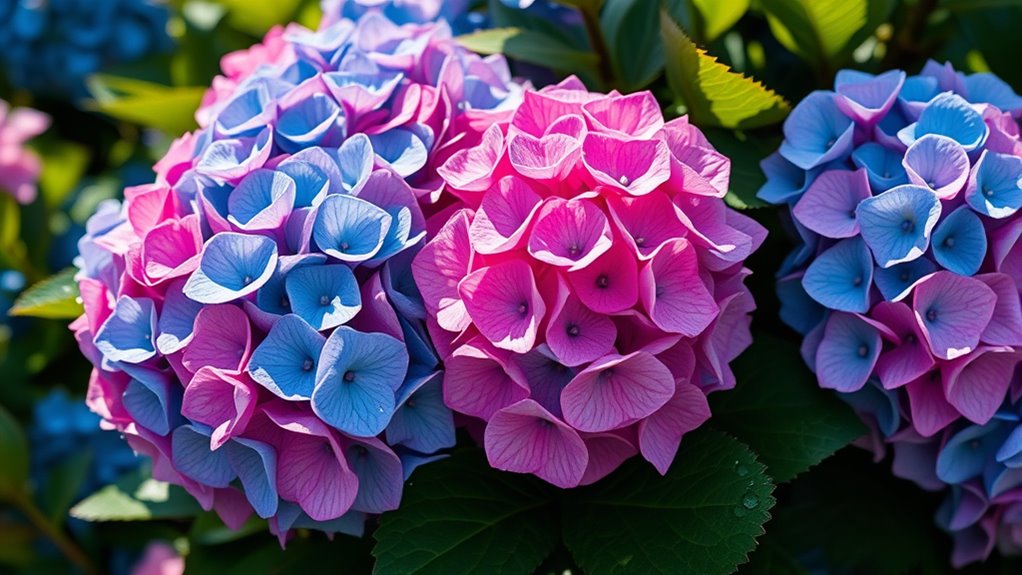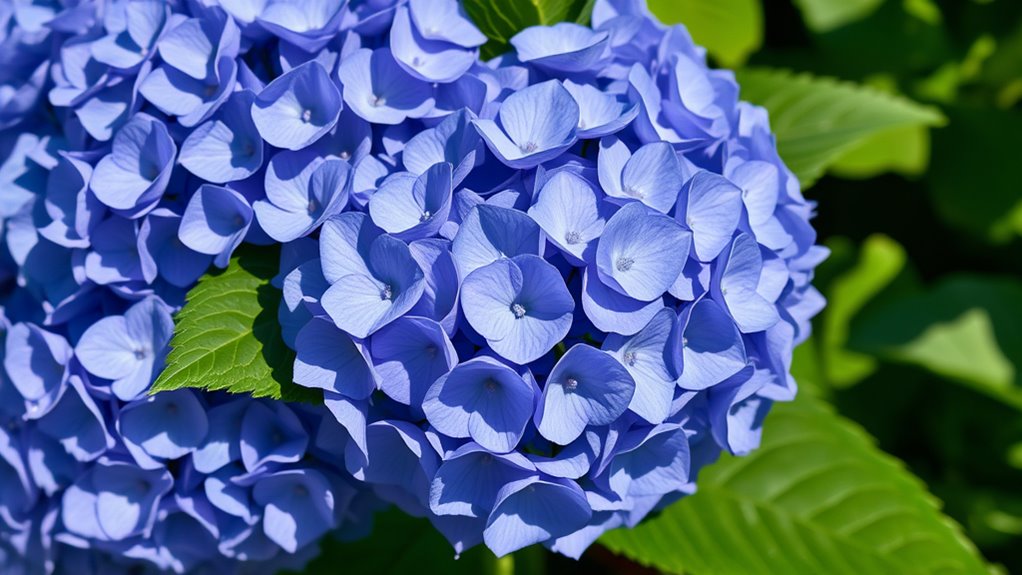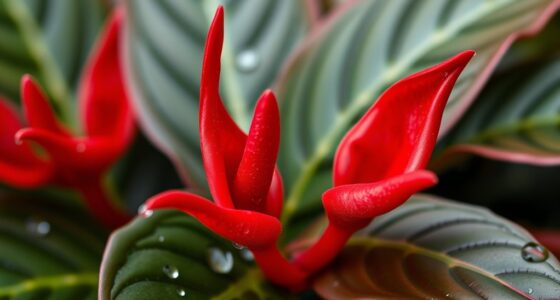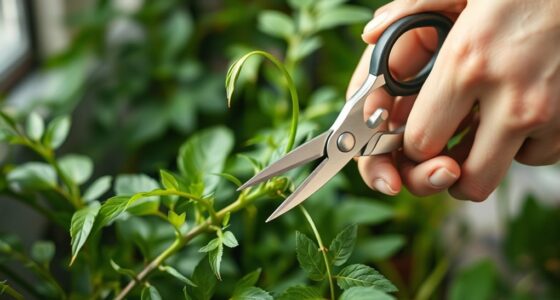To get big, beautiful hydrangea blooms with little fuss, plant them in well-draining, slightly acidic soil and mulch regularly to retain moisture. Prune at the right time—immediately after flowering for old wood bloomers, or early spring for new wood types—to encourage healthy growth. Water consistently during dry spells and fertilize early in the season. Proper care of soil, pruning, and watering will keep your hydrangeas vibrant—learn more to master their care.
Key Takeaways
- Prune hydrangeas at the right time based on whether they bloom on old or new wood to promote big, healthy blooms.
- Plant in well-draining, slightly acidic soil enriched with organic matter to support vibrant flowering with minimal fuss.
- Water consistently, especially during dry periods, and mulch to retain moisture and maintain optimal soil conditions.
- Fertilize early spring with a balanced, slow-release fertilizer to encourage strong growth and larger blooms.
- Regularly check and maintain proper pruning, soil health, and watering habits to keep hydrangeas thriving with minimal effort.

Hydrangeas are beautiful, versatile shrubs that can brighten any garden, but they require proper care to thrive. One of the most important aspects of caring for your hydrangeas is understanding pruning techniques. Proper pruning encourages healthy growth, larger blooms, and maintains the shrub’s shape. When pruning, you need to know whether your hydrangea blooms on old wood or new wood. For those that bloom on old wood, prune immediately after flowering to avoid cutting off next year’s buds. For varieties that bloom on new wood, you can prune in early spring, removing dead or weak stems to promote vigorous growth. Always use clean, sharp tools to make clean cuts, and avoid removing more than one-third of the plant at a time. This guarantees you don’t stress the shrub and that it can recover quickly, producing abundant flowers.
Another key to successful hydrangea care is understanding soil requirements. These plants thrive in well-draining soil that retains moisture but isn’t soggy. Hydrangeas prefer slightly acidic to neutral soil, with a pH between 5.5 and 6.5. If your soil tends to be alkaline, you might notice less vibrant blooms, especially in certain varieties like the bigleaf hydrangea, which can change color based on soil acidity. To optimize soil conditions, mix in organic matter such as compost or peat moss, which improves drainage and provides essential nutrients. Mulching around the base of the plant also helps retain moisture, regulate soil temperature, and suppress weeds. Regularly check your soil’s moisture level, especially during hot or dry periods, to prevent stress on the plant. Hydrangeas don’t like to sit in waterlogged soil, so ensure your planting site has good drainage, or consider planting in raised beds if necessary.
In addition to pruning and soil care, you should also pay attention to watering habits and fertilization. Hydrangeas need consistent watering, especially during dry spells, to keep their roots moist but not waterlogged. Fertilize them in early spring with a balanced, slow-release fertilizer to promote healthy growth and flower production. Follow the manufacturer’s instructions carefully, as over-fertilizing can lead to lush foliage at the expense of blooms.
Frequently Asked Questions
How Do I Prevent Wilting During Hot Summer Days?
To prevent wilting during hot summer days, you should focus on proper watering techniques, ensuring your hydrangea gets deep, consistent moisture. Water early in the morning or late in the evening to reduce evaporation. Additionally, consider shade options like planting your hydrangea in a location with afternoon shade or using a shade cloth. These steps help keep roots cool and maintain hydration, keeping your blooms vibrant and healthy.
What Are Common Pests That Affect Hydrangeas?
You might think pests don’t bother hydrangeas, but pest identification shows they’re common troublemakers. Aphids, spider mites, and scale insects are frequent culprits, causing damage and weakening plants. Surprisingly, natural remedies like neem oil or insecticidal soap can effectively combat these pests without harsh chemicals. Regularly inspect your hydrangeas, act early, and keep pests in check to guarantee vibrant, healthy blooms all season long.
Can Hydrangeas Be Grown in Containers Year-Round?
You can absolutely grow hydrangeas in containers year-round, but it requires some seasonal maintenance. In colder months, move your container gardening hydrangea to a sheltered spot or insulate it to protect against frost. During warmer seasons, guarantee it gets adequate watering and occasional fertilizing. Container gardening offers flexibility, but staying attentive to seasonal changes helps your hydrangea thrive and keeps those big, beautiful blooms coming year-round.
How Do I Prune for Reblooming Varieties?
To encourage reblooming, you should use proper pruning techniques based on your hydrangea’s reblooming schedule. For reblooming varieties, prune lightly after the first bloom, removing dead or weak stems and shaping the plant. Avoid heavy pruning in late winter or early spring, as it can remove buds for the next bloom. Regular, strategic pruning helps make certain vibrant, continuous blooms throughout the season.
What’s the Best Way to Fertilize Hydrangeas?
You want lush hydrangeas, so you need the right fertilization routine. Focus on fertilizer timing—apply in early spring and mid-summer for continuous blooms. Decide between organic or synthetic fertilizers based on your preference; organic options enrich the soil naturally, while synthetic ones deliver quick nutrients. Keep your hydrangeas thriving by feeding them consistently, avoiding over-fertilizing, and watching them flourish with big, beautiful blooms all season long.
Conclusion
With just a little attention, hydrangeas can flourish like a well-tuned orchestra, filling your garden with stunning blooms. Keep an eye on watering, prune wisely, and provide the right sunlight, and you’ll enjoy big, beautiful flowers with minimal fuss. Think of your hydrangea as a loyal friend—easy to care for when you know what it needs. With these simple tips, your hydrangea will reward you with vibrant blooms season after season.









